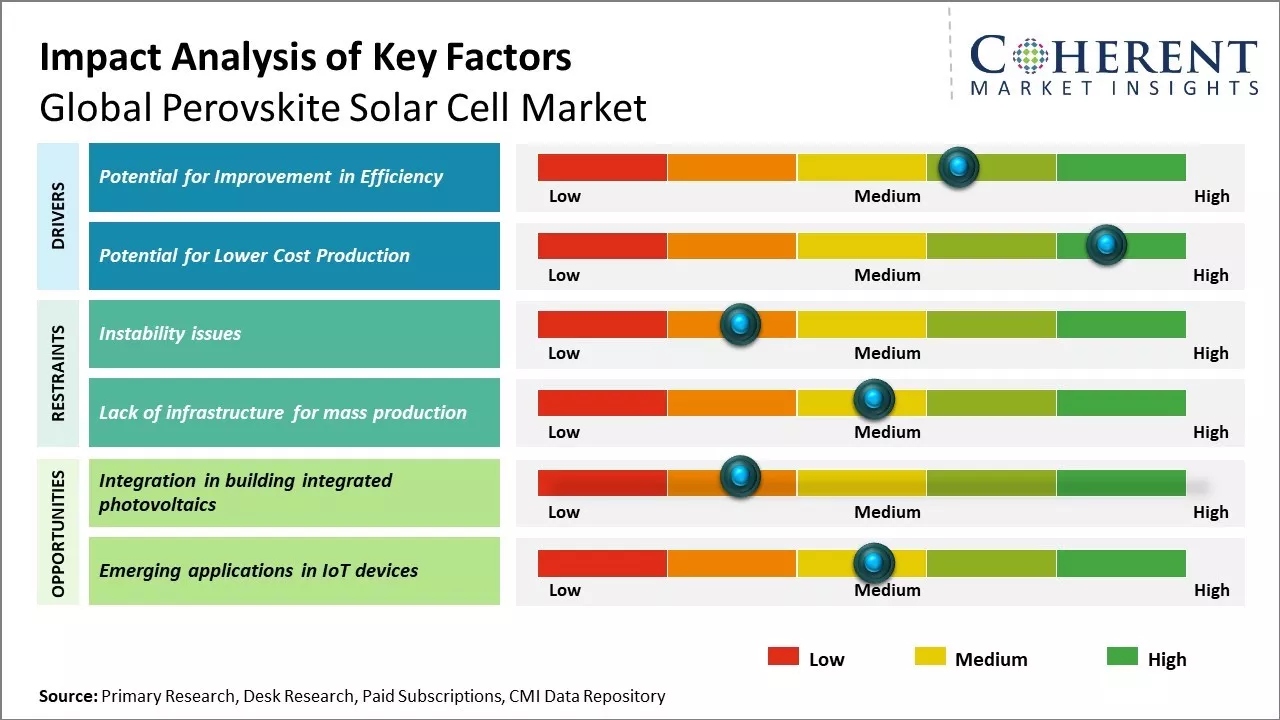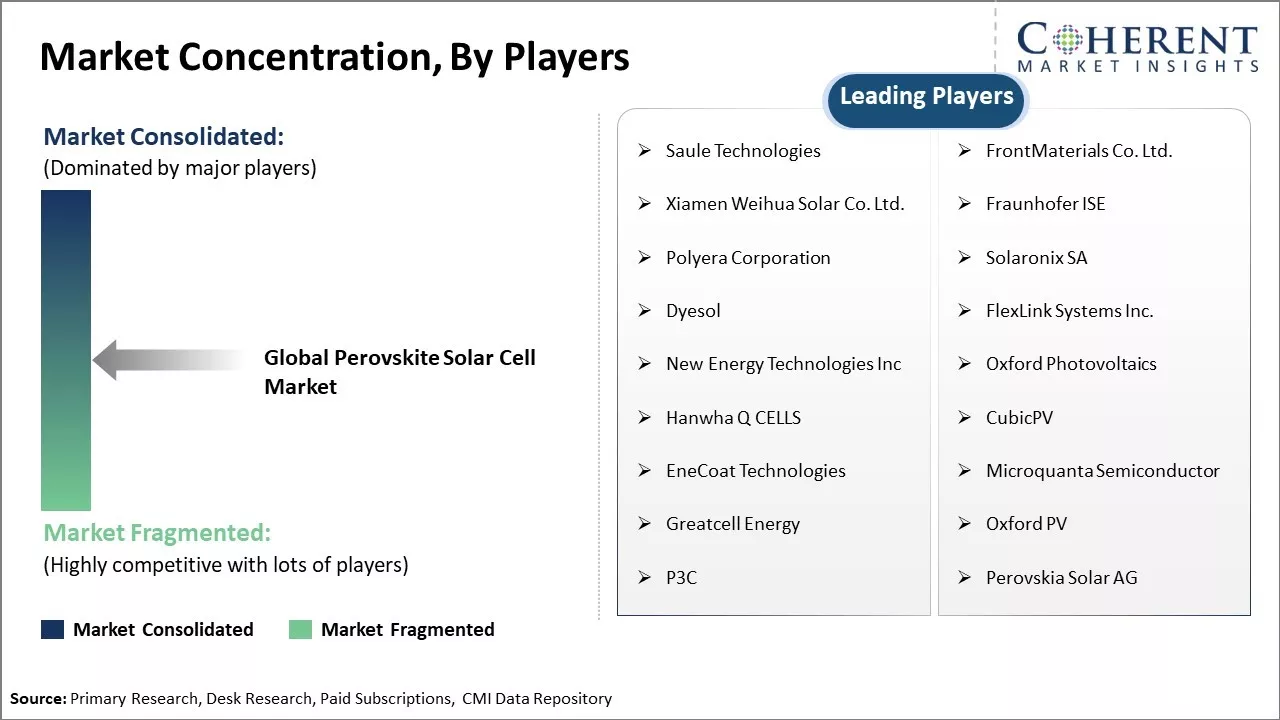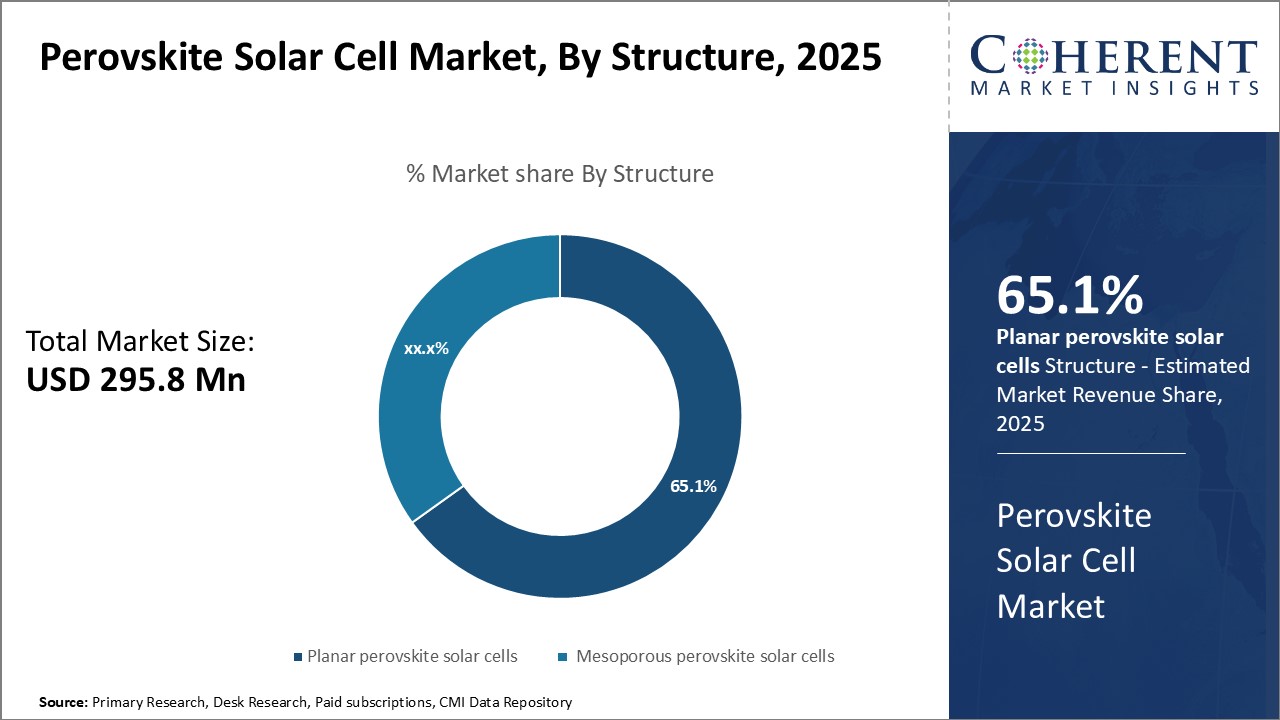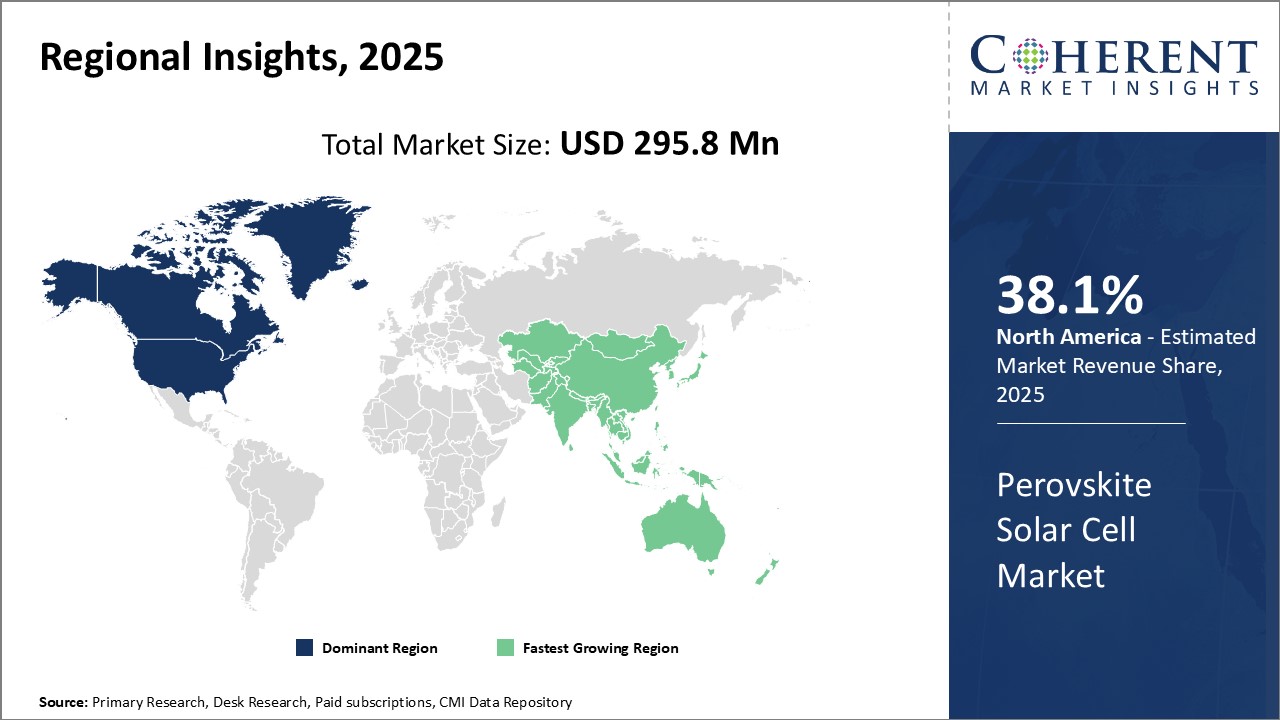Perovskite Solar Cell Market Size and Trends
Global perovskite solar cell market is estimated to be valued at USD 295.8 Mn in 2025 and is expected to reach USD 6,958.2 Mn by 2032, exhibiting a compound annual growth rate (CAGR) of 57.0% from 2025 to 2032.

Discover market dynamics shaping the industry: Download Free Sample
High efficiency even at lower production costs compared to silicon solar panels can boost demand for perovskite solar cells globally. The continuous innovation such as developing solar cells that can work efficiently even in low light conditions is expected to boost sales of perovskite solar cells. Increasing investment by both public and private entities to promote renewable sources of energy including solar energy can drive the perovskite solar cell market growth in the near future.
Potential for Improvement in Efficiency
The potential for improving efficiency is a major factor propelling the global perovskite solar cell market forward. Perovskite solar cells offer significantly higher efficiencies than traditional silicon-based photovoltaic cells, with efficiencies increasing rapidly in recent times. According to the National Renewable Energy Laboratory (NREL), the average efficiency of commercially available silicon solar panels is around 16-22%, whereas experimental perovskite cells have achieved efficiency rates as high as 25.5%. This potential for even higher efficiency gains is attracting considerable research and commercial interest. As efficiencies increase, perovskite cells will approach the efficiency of crystalline silicon solar panels at a fraction of the cost due to simplicity of fabrication processes involved. Large-scale production costs of perovskite cells could be 10 times lower than crystalline silicon. The ability to produce low-cost high-efficiency solar power opens up new applications and markets. According to the International Energy Agency (IEA), the levelized cost of electricity from residential rooftop perovskite systems could potentially be lower than retail electricity rates in many parts of the world within the next 5 years. This will make solar energy more competitive compared to fossil fuel alternatives and help expand the solar market beyond utility-scale projects.
Market Concentration and Competitive Landscape

Get actionable strategies to beat competition: Download Free Sample
Potential for Lower Cost ProductionThe potential for significantly lower manufacturing costs as compared to conventional silicon photovoltaic technology can drive the market growth. One of the main reasons silicon has dominated is its economics prevailed over thin film rivals like CdTe and CIGS. However, perovskite production costs show potential to usher in a new era of even lower price photovoltaics. This advantage stems from perovskite cells being solution processable from inexpensive raw materials using techniques like slot-die coating or inkjet printing which enable high-volume roll-to-roll manufacturing. Fabricating perovskite films is a low-temperature process suitable for flexible plastic substrates versus the high temperatures required for crystalline silicon manufacturing. Furthermore, perovskite materials does not require energy-intensive refinement and does not use expensive semiconductor manufacturing equipment. Perovskite components are abundantly available unlike scarce raw materials in thin-film technologies like tellurium and indium.
Key Takeaways from Analyst:
Global perovskite solar cell market growth is driven by its promising efficiency and cost advantages over existing solar technologies. The simple manufacturing process of perovskite solar cells using low-cost materials enables significantly lower costs compared to crystalline silicon and cadmium telluride thin film solar. Furthermore, efficiency improvements and demonstrated operational stability can offer new opportunities for both small and large-scale adoption.
Asia Pacific currently dominates the perovskite solar cell market due to presence of leading research hub and manufacturing base in China and Asia's high solar energy demand. Continuous policy support for solar energy adoption can drive the market growth in the region. However, with rising R&D investments, Europe is emerging as a key innovator in terms of efficiency enhancements and commercialization efforts. Parts of the U.S. is also showing strong commitment to perovskite technology development.
The need for operational stability under varying weather conditions is one of the major challenges holding back mass commercialization of perovskite solar modules. Extended lifetime and safety issues relating to heavy metal content also require extensive research efforts. High manufacturing costs compared to silicon at current prototype scale pose a key restraint. Overall adoption will depend on improved durability and lowering production costs to achieve grid parity with silicon-based solutions.
Market Challenge: Instability issues
Instability issues can hamper the growth of perovskite solar cell market. Perovskite solar cells contain organic-inorganic metal halide perovskites as the light-harvesting material. However, the material is highly susceptible to moisture and oxygen degradation, which affects the long-term stability and durability of the solar cells. When exposed to humid conditions or atmospheric oxygen, the perovskite material breaks down within a few hours or days. This instability issue translates to a shorter useful lifetime for perovskite solar panels as compared to conventional silicon-based solar panels. Such reliability concerns can hamper mass adoption of the technology.
Market Opportunity: Integration in building integrated photovoltaics
Integration of perovskite solar cells into building integrated photovoltaics (BIPV can offer opportunity for the market growth. Perovskites offer flexibility and semitransparency, making these well-suited for applications like windows, roofs and facades that can generate solar power while serving an architectural function. As the built environment accounts for around 40% of global electricity consumption, BIPV could make a major contribution to reducing carbon emissions.

Discover high revenue pocket segments and roadmap to it: Download Free Sample
Insights, By Structure: Technological advancements drives planar perovskite solar cells segment growthIn terms of structure, planar perovskite solar cells segment is estimated to contribute the 65.1% share of the market in 2025, owing to ongoing technological advancements that are expanding its functionality. Planar devices offer a simpler architecture as compared to mesoporous cells and allow for large-scale production using high-throughput coating and printing techniques. The ability to fabricate planar cells using scalable processes significantly reduces manufacturing costs. Ongoing research is also exploring new perovskite compositions and cell designs that enable planar cells to achieve higher power conversion efficiencies. This is attracting greater commercial interest from solar manufacturers. Planar perovskite solar cells have demonstrated high stability when integrated with protection layers, increasing their feasibility for deployment in real-world conditions. The continuous enhancements in efficiency, scalability and durability of planar perovskite solar cells through technological innovations can boost their adoption over other structures.
Insights, By Product Type: Flexibility appeals to diverse end-user industries
In terms of product type, flexible segment is estimated to contribute the 68.1% share of the market in 2025, owing to its ability to appeal to diverse end user industries. Flexible perovskite solar cells can be lightweight, bendable and semi-transparent. This makes them highly suitable for integration into building facades, vehicles, portable consumer devices and wearable electronics. Many industries are eager to utilize flexible perovskite solar technology as it allows them to design new product form factors not possible with traditional rigid silicon panels. Flexible solar films can also be mass produced through roll-to-roll printing, thus, lowering manufacturing costs. Growing demand from industries seeking versatile, aesthetically-pleasing and cost-efficient renewable energy sources continues to drive innovations around flexible perovskite solar cells.
Insights, By End User: Rising role of renewables in the energy sector
In terms of end user, energy segment is estimated to contribute the 36.1% share of the market in 2025 due to sector's increased emphasis on renewable sources. Perovskite solar technology offers the promising attributes of high efficiency and low-cost that energy companies require to transition away from fossil fuels. Perovskite solar panels may potentially help utility-scale projects and residential rooftop installations to generate greener electricity. Incorporating renewables also enables the energy industry to meet stringent environmental regulations and sustainability targets. With perovskite solar cells becoming more stable and scalable through ongoing R&D, their role as a renewable alternative to traditional photovoltaic options is growing in the utility-scale solar power generation space. The perovskite market stands to significantly benefit from the energy sector's enhanced focus on renewable integration and carbon-neutral goals in the coming years.
Regional Insights

Need a Different Region or Segment? Download Free Sample
North America region currently dominates the perovskite solar cell market with estimated 38.1% share in 2025. The U.S. has developed strong technological capabilities in solar cell manufacturing over the years. Major American players like SolarCity, First Solar, and others are investing heavily in R&D to be at the forefront of new solar technologies. Abundant venture capital funding and government incentives have helped perovskite startups to scale up their operations in the U.S. The presence of highly research universities is also driving innovation. Many universities are actively collaborating with American manufacturers to develop more efficient and stable perovskite cells. Growing commercial and residential solar installations are rapidly expanding the market for newer, more viable solar options in North America. Several U.S. based companies are on the verge of commercializing their perovskite products to leverage this huge untapped market. Once it achieves mass production capabilities, the North American market will witness rapid adoption of this new solar technology. Strong manufacturing infrastructure coupled with a large domestic demand makes North America an ideal region to establish perovskite industry standards.
The Asia Pacific region, especially China, is emerging as the fastest growing market for perovskite solar cells. Chinese solar manufacturers see perovskite as a next big opportunity to capture global market share. It has invested significantly in expanding perovskite manufacturing capacities over the past year. China also has a large workforce which allows manufacturers to scale up at relatively lower costs. Perovskite imports have risen sharply with many global startups partnering with Chinese industry players for mass production. Government bodies in China offer multiple incentives such as tax breaks, financing options, and others for development of new renewable technologies. This is fueling rapid capacity expansion of perovskite makers. Infrastructure development, strong foreign investment and growing domestic solar installations can drive the market growth in the region.
Market Report Scope
Perovskite Solar Cell Market Report Coverage
| Report Coverage | Details | ||
|---|---|---|---|
| Base Year: | 2024 | Market Size in 2025: | USD 295.8 Mn |
| Historical Data for: | 2020 To 2024 | Forecast Period: | 2025 To 2032 |
| Forecast Period 2025 to 2032 CAGR: | 57.0% | 2032 Value Projection: | USD 6,958.2 Mn |
| Geographies covered: |
|
||
| Segments covered: |
|
||
| Companies covered: |
Saule Technologies, FrontMaterials Co. Ltd., Xiamen Weihua Solar Co. Ltd., Fraunhofer ISE, Polyera Corporation, Solaronix SA, Dyesol, FlexLink Systems Inc., New Energy Technologies Inc, Oxford Photovoltaics, Hanwha Q CELLS, CubicPV, EneCoat Technologies, Microquanta Semiconductor, Greatcell Energy, Oxford PV, P3C, Perovskia Solar AG |
||
| Growth Drivers: |
|
||
| Restraints & Challenges: |
|
||
Uncover macros and micros vetted on 75+ parameters: Get instant access to report
Perovskite Solar Cell Industry News
- In April 2024, Solaires and XLYNX collaborated to build high efficiency perovskite solar cells
- In January 2024, RenShine Solar announced the completion of its 150MW perovskite PV module project in Changsgu, China, which had begun in April 2023.
- In February 2023, Oxford PV announced its plans to launch its perovskite-on-silicon tandem cell, with a predicted conversion efficiency of 27% and an energy yield of 24%.
- In February 2023, the IPVF solar institute in France announced a partnership with Voltec Solar to build a solar panel factory that will produce Tandem 4T Perovskite/Silicon cells, with the goal of starting production in 2025
*Definition: Perovskite Solar Cell Market involves the research and development of solar cells that use a type of material called perovskite, which is a crystal structure that certain minerals form in. Perovskite solar cells are being developed as a potentially cheaper alternative to traditional silicon-based solar panels that can be produced using simple and low-cost techniques like solution processing from inks or vapors.
Market Segmentation
- Structure Insights (Revenue, USD Mn, 2020 - 2032)
- Planar perovskite solar cells
- Mesoporous perovskite solar cells
- Product Type Insights (Revenue, USD Mn, 2020 - 2032)
- Rigid
- Flexible
- End User Insights (Revenue, USD Mn, 2020 - 2032)
- Aerospace
- Industrial automation
- Consumer Electronics
- Energy
- Others
- Regional Insights (Revenue, USD Mn, 2020 - 2032)
- North America
- U.S.
- Canada
- Latin America
- Brazil
- Argentina
- Mexico
- Rest of Latin America
- Europe
- Germany
- U.K.
- Spain
- France
- Italy
- Russia
- Rest of Europe
- Asia Pacific
- China
- India
- Japan
- Australia
- South Korea
- ASEAN
- Rest of Asia Pacific
- Middle East & Africa
- GCC Countries
- Israel
- Rest of Middle East & Africa
- North America
- Key Players Insights
- Saule Technologies
- FrontMaterials Co. Ltd.
- Xiamen Weihua Solar Co. Ltd.
- Fraunhofer ISE
- Polyera Corporation
- Solaronix SA
- Dyesol
- FlexLink Systems Inc.
- New Energy Technologies Inc
- Oxford Photovoltaics
- Hanwha Q CELLS
- CubicPV
- EneCoat Technologies
- Microquanta Semiconductor
- Greatcell Energy
- Oxford PV
- P3C
- Perovskia Solar AG
Share
Share
About Author
Yash Doshi is a Senior Management Consultant. He has 12+ years of experience in conducting research and handling consulting projects across verticals in APAC, EMEA, and the Americas.
He brings strong acumen in helping chemical companies navigate complex challenges and identify growth opportunities. He has deep expertise across the chemicals value chain, including commodity, specialty and fine chemicals, plastics and polymers, and petrochemicals. Yash is a sought-after speaker at industry conferences and contributes to various publications on topics related commodity, specialty and fine chemicals, plastics and polymers, and petrochemicals.
Missing comfort of reading report in your local language? Find your preferred language :
Transform your Strategy with Exclusive Trending Reports :
Frequently Asked Questions
EXISTING CLIENTELE
Joining thousands of companies around the world committed to making the Excellent Business Solutions.
View All Our Clients
